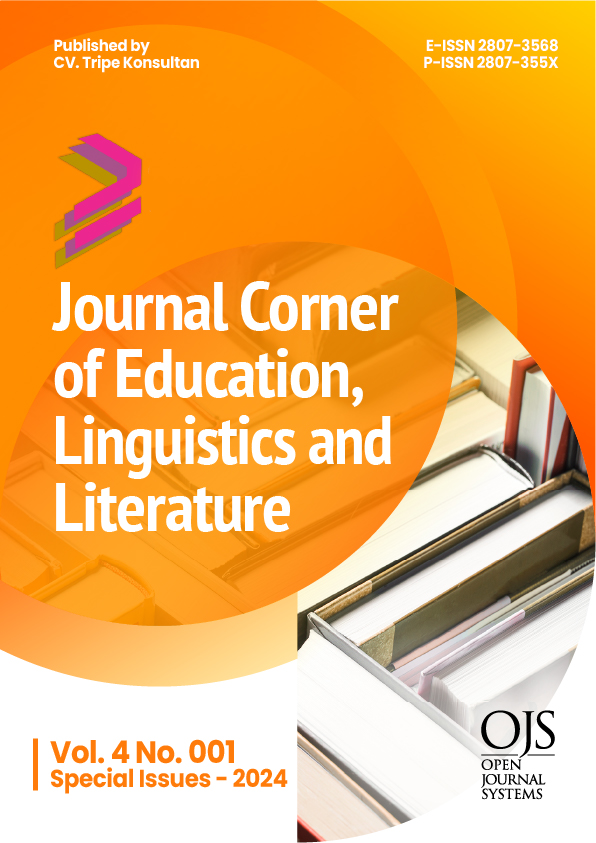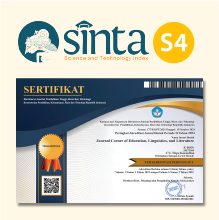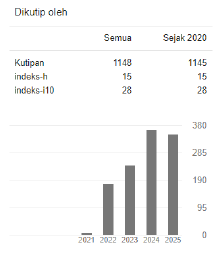The Implementation of Internal and External Quality Assurance Systems at the Private Islamic Higher Education
(A Case Study at STAI Al Badar Cipulus Purwakarta)
 https://doi.org/10.54012/jcell.v4i001.397
https://doi.org/10.54012/jcell.v4i001.397
 Abstract views: 161
Abstract views: 161
 PDF downloads: 113
PDF downloads: 113
Keywords:
internal and external quality assurance systems, management, private Islamic higher educationAbstract
Quality assurance at higher education becomes main priority, including at private Islamic higher education (PTKIS). This study analyzes the implementation of SPMI and SPME and identifies the obstacles and strategies taken to optimize the implementation of SPMI and SMPE at STAI Al Badar Cipulus Purwakarta. This study employs qualitative approach under a case study, at which the data were collecyed through interview, observation, and document analysis. The findings of the study show that the implementation of SPMI and SPME at STAI Al Badar Cipulus Purwakarta refers to planning, implementing, monitoring, evaluating, and improving the quality of education which is carried out by involving the entire academic community, including institustion leaders, lecturers, and quality management staff. In addition, the obstacles faced by STAI Al Badar in implementing SPMI and SPME consist of internal and external obstacles. Meanwhile, the strategies taken to optimize the implementation of SPMI and SMPE cover: (a) human resource training, (b) technology use training, and (c) strengthening strategic partnerships.
Downloads
References
Abdus Syukur, I., Suherman, D., Gaffar, M. A., & Mardiana, D. (2022). Implementation Of Standard-Setting To Improve Performance Implementation Of Standards Of Internal Quality Assurance Systems Private Universities. International Journal of Educational Research & Social Sciences, 3(5), 1935–1942. https://doi.org/10.51601/ijersc.v3i5.477
Barney, J. (1991). Firm Resources and Sustained Competitive Advantage. Journal of Management, 17(1), 99–120. https://doi.org/10.1177/014920639101700108
Braun, V., & Clarke, V. (2006). Using Thematic Analysis in Psychology. Qualitative Research in Psychology, 3(2), 77–101.
Creswell, J. W. (2014). Research Design: Qualitative, Quantitative, and Mixed Methods Approaches. London, United Kingdom: SAGE Publication, Inc.
Deming, W. E. (1986). Out of the Crisis. Cambridge, MA: Center for Advanced Engineering Study, Massachusetts Institute of Technology.
Freeman, R. E. (1984). Strategic Management: A Stakeholder Approach. Boston, MA: Pitman.
Gofur, H. A., Qomusuddin, I. F., & Romlah, S. (2023). Desain Sistem Penjaminan Mutu Internal (SPMI) Perguruan Tinggi Keagamaan Islam Swasta (PTKIS). JSIM: Jurnal Ilmu Sosial Dan Pendidikan, 4(5), 601–608. https://doi.org/10.36418/syntax-imperatif.v4i5.290
Gunawan, J., & Waluyo, B. M. (2022). Sistem Penjaminan Mutu Internal (SPMI) Berdasarkan Undang-Undang No. 12 Tahun 2012 tentang Pendidikan Tinggi dan Permenristekdikti No. 62 Tahun 2016 Tentang SPM Dikti. Jakarta: Kementerian Pendidikan, Kebudayaan, Riset, dan Teknologi.
Gvaramadze, I. (2008). From Quality Assurance to Quality Enhancement in the European Higher Education Area. European Journal of Education, 43(4), 443–455. https://doi.org/10.1111/j.1465-3435.2008.00376.x
Hambali, A., Herniawati, A., & Hidayat, Y. (2024). Scope of the Philosophy of Science: A Review of Philosophical Education. Journal Corner of Education, Linguistics, and Literature, 3(3), 231–240. https://doi.org/10.54012/jcell.v3i3.263
Haris, I. (2013). Assessment on the implementation of internal quality assurance at higher education (an Indonesian report). Journal of Educational and Instructional Studies in the World, 3(4), 45–49.
Herniawati, A., Hidayat, Y., Hasanah, A., & Arifin, B. S. (2024). The Qur’anic Methods in Instilling Characters in a family: An Educational Perspective. International Journal Corner of Educational Research, 3(2), 87–94.
Hidayat, Y., & Nurlatifah, L. (2023). Analisis komparasi tingkat pencapaian perkembangan anak usia dini (STPPA) berdasarkan permendikbud no. 137 tahun 2014 dengan permendikbudristek no. 5 tahun 2022. Jurnal Intisabi, 1(1), 29–40. https://doi.org/10.61580/itsb.v1i1.4
Mulyono, N., Herniawati, A., & Hidayat, Y. (2023). Bedtime storytelling: A method to enhance early childhoods’ language development. Jurnal Pendidikan Anak Usia Dini Undiksha, 11(3), 61–69. https://doi.org/10.23887/paud.v11i3.68552
Nguyen, L. T. M., Tran, T., Pham, T. Van, Nguyen, T.-T., Le, H. T. T., Trinh, T. T. P., & Nghiem, T. T. (2021). Factors Affecting Successful Quality Assurance Implementation in Vietnamese Higher Education: A Qualitative Study. The Qualitative Report. https://doi.org/10.46743/2160-3715/2021.4564
Psomas, E., & Antony, J. (2017). Total quality management elements and results in higher education institutions. Quality Assurance in Education, 25(2), 206–223. https://doi.org/10.1108/QAE-08-2015-0033
Rohiat, R. (2010). Manajemen Sekolah: Teori Dasar dan Praktik. Bandung: PT. Refika Aditama.
Sulaiman, A., & Wibowo, U. B. (2016). Implementasi Sistem Penjaminan Mutu Internal Sebagai Upaya Meningkatkan Mutu Pendidikan di Universitas Gadjah Mada. Jurnal Akuntabilitas Manajemen Pendidikan, 4(1), 17–32. https://doi.org/10.21831/amp.v4i1.8197
Supriatna, A., Harits, B., & Azis, Y. M. A. (2022). Strategy Evaluation Policy Implementation Of Quality Assurance System In Improving The Competitiveness Of Private Universities In Bandung. Journal of Positive School Psychology, 6(7), 3934–3946.
Teece, D. J., Pisano, G., & Shuen, A. (1998). Dynamic Capabilities and Strategic Management. Strategic Management Journal, 18(7), 509–533. https://doi.org/10.1002/(SICI)1097-0266(199708)18:7%3C509::AID-SMJ882%3E3.0.CO;2-Z
UNESCO. (2018). Internal Quality Assurance: Enhancing higher education quality and graduate employability. France: International Institute for Educational Planning.
Welsh, J. F., & Dey, S. (2002). Quality measurement and quality assurance in higher education. Quality Assurance in Education, 10(1), 17–25. https://doi.org/10.1108/09684880210416076
Yin, R. K. (2018). Case study research and applications: Design and methods, sixth edition. London: SAGE Publications, Inc.
Downloads
Published
How to Cite
Issue
Section
License
Copyright (c) 2024 Ani Herniawati, Ujang Miftahudin, Zam zam Lukmanul Jamil, Yusuf Hidayat, Uus Ruswandi

This work is licensed under a Creative Commons Attribution-ShareAlike 4.0 International License.
All articles published in the Journal Corner of Education, Linguistics, and Literature are licensed under the Creative Commons Attribution-ShareAlike License (CC BY-SA).

















